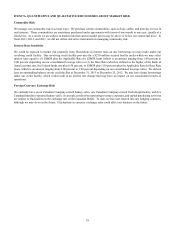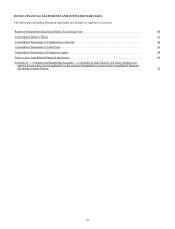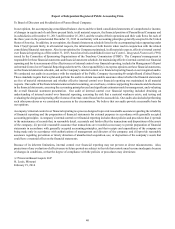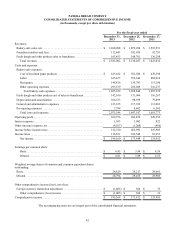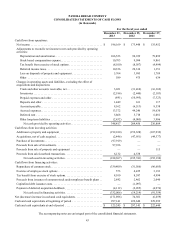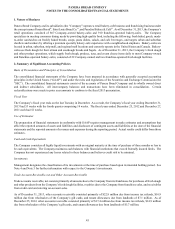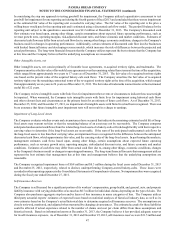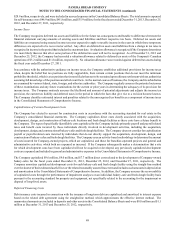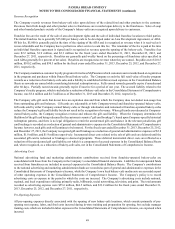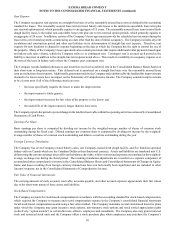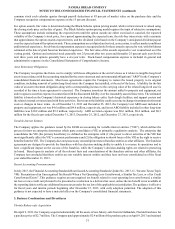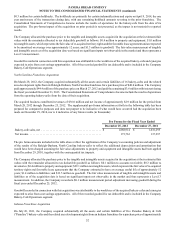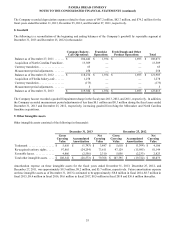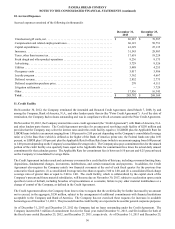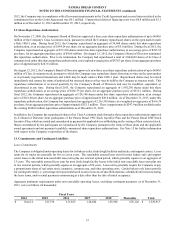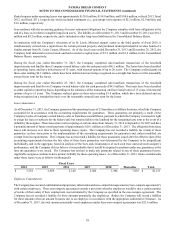Panera Bread 2013 Annual Report Download - page 56
Download and view the complete annual report
Please find page 56 of the 2013 Panera Bread annual report below. You can navigate through the pages in the report by either clicking on the pages listed below, or by using the keyword search tool below to find specific information within the annual report.PANERA BREAD COMPANY
NOTES TO THE CONSOLIDATED FINANCIAL STATEMENTS (continued)
48
$28.9 million, respectively, and were included in accrued expenses in the Consolidated Balance Sheets. The total amounts expensed
for self-insurance were $46.9 million, $41.8 million, and $35.9 million, for the fiscal years ended December 31, 2013, December 25,
2012, and December 27, 2011, respectively.
Income Taxes
The Company recognizes deferred tax assets and liabilities for the future tax consequences attributable to differences between the
financial statement carrying amounts of existing assets and liabilities and their respective tax basis. Deferred tax assets and
liabilities are measured using enacted income tax rates expected to apply to taxable income in the years in which those temporary
differences are expected to be recovered or settled. Any effect on deferred tax assets and liabilities from a change in tax rates is
recognized in income in the period that includes the enactment date. A valuation allowance is recognized if the Company determines
it is more likely than not that all or some portion of the deferred tax asset will not be recognized. As of December 31, 2013 and
December 25, 2012, the Company had recorded a valuation allowance related to deferred tax assets of the Company's Canadian
operations of $3.2 million and $1.8 million, respectively. No valuation allowance was recorded against deferred tax assets during
the fiscal year ended December 27, 2011.
In accordance with the authoritative guidance on income taxes, the Company establishes additional provisions for income taxes
when, despite the belief that tax positions are fully supportable, there remain certain positions that do not meet the minimum
probability threshold, which is a tax position that is more likely than not to be sustained upon ultimate settlement with tax authorities
assuming full knowledge of the position and all relevant facts. In the normal course of business, the Company and its subsidiaries
are examined by various federal, state, foreign, and other tax authorities. The Company regularly assesses the potential outcomes
of these examinations and any future examinations for the current or prior years in determining the adequacy of its provision for
income taxes. The Company routinely assesses the likelihood and amount of potential adjustments and adjusts the income tax
provision, the current tax liability and deferred taxes in the period in which the facts that give rise to a revision become known.
The Company classifies estimated interest and penalties related to the unrecognized tax benefits as a component of income taxes
in the Consolidated Statements of Comprehensive Income.
Capitalization of Certain Development Costs
The Company has elected to account for construction costs in accordance with the accounting standard for real estate in the
Company’s consolidated financial statements. The Company capitalizes direct costs clearly associated with the acquisition,
development, design, and construction of bakery-cafe locations and fresh dough facilities as these costs have a future benefit to
the Company. The types of specifically identifiable costs capitalized by the Company include primarily payroll and payroll related
taxes and benefit costs incurred by those individuals directly involved in development activities, including the acquisition,
development, design, and construction of bakery-cafes and fresh dough facilities. The Company does not consider for capitalization
payroll or payroll-related costs incurred by individuals that do not directly support the acquisition, development, design, and
construction of bakery-cafes and fresh dough facilities. The Company uses an activity-based methodology to determine the amount
of costs incurred for Company-owned projects, which are capitalized, and those for franchise-operated projects and general and
administrative activities, which both are expensed as incurred. If the Company subsequently makes a determination that a site
for which development costs have been capitalized will not be acquired or developed, any previously capitalized development
costs are expensed and included in general and administrative expenses in the Consolidated Statements of Comprehensive Income.
The Company capitalized $9.6 million, $9.0 million, and $7.7 million direct costs related to the development of Company-owned
bakery-cafes for the fiscal years ended December 31, 2013, December 25, 2012, and December 27, 2011, respectively. The
Company amortizes capitalized development costs for each bakery-cafe and fresh dough facility using the straight-line method
over the shorter of their estimated useful lives or the related reasonably assured lease term and includes such amounts in depreciation
and amortization in the Consolidated Statements of Comprehensive Income. In addition, the Company assesses the recoverability
of capitalized costs through the performance of impairment analyses on an individual bakery-cafe and fresh dough facility basis
pursuant to the accounting standard for property and equipment, net specifically related to the accounting for the impairment or
disposal of long-lived assets.
Deferred Financing Costs
Debt issuance costs incurred in connection with the issuance of long-term debt are capitalized and amortized to interest expense
based on the related debt agreement using the straight-line method, which approximates the effective interest method. The
unamortized amounts are included in deposits and other assets in the Consolidated Balance Sheets and were $0.8 million and $1.1
million at December 31, 2013 and December 25, 2012, respectively.


